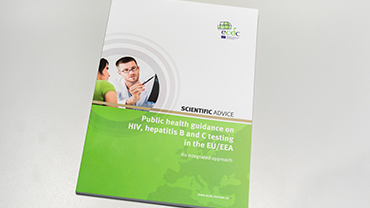Antimicrobial consumption in the EU/EEA (ESAC-Net) - Annual Epidemiological Report for 2021
For 2021, 29 countries (27 European Union (EU) Member States and two European Economic Area (EEA) countries – Iceland and Norway) reported data on antimicrobial consumption. Twenty-seven countries reported consumption data for the community and hospital sectors separately, one country (Cyprus) reported total consumption for both sectors combined, and one country (Germany) reported only community consumption.
Executive summary
Key facts
- For 2021, 29 countries (27 European Union (EU) Member States and two European Economic Area (EEA) countries – Iceland and Norway) reported data on antimicrobial consumption. Twenty-seven countries reported consumption data for the community and hospital sectors separately, one country (Cyprus) reported total consumption for both sectors combined, and one country (Germany) reported only community consumption.
- Antimicrobial consumption is expressed as the number of defined daily doses (DDD) per 1 000 inhabitants per day. The Anatomical Therapeutic Chemical (ATC) classification index with Defined Daily Doses (DDDs) 2022 was used for the analysis of both 2021 data and historical data.
- In 2021, the EU/EEA population-weighted mean total (community and hospital sectors combined) consumption of antibacterials for systemic use (ATC group J01) was 16.4 DDD per 1 000 inhabitants per day (country range: 8.3–25.7). During the period 2012–2021, a statistically significant decrease was observed for the EU/EEA population-weighted mean overall, as well as for 13 individual countries. A statistically significant increasing trend was observed for one country (Bulgaria).
- The EU/EEA population-weighted mean total (community and hospital sectors combined) consumption of antivirals for systemic use (ATC group J05) was 2.72 DDD per 1 000 inhabitants per day (country range: 0.28–6.25), with no statistically significant trend in the five-year period 2017–2021.
Community (primary care sector)
- In the community, the EU/EEA population-weighted mean consumption of antibacterials for systemic use (ATC group J01) was 15.0 DDD per 1 000 inhabitants per day (country range: 7.2–24.3). During the period 2012–2021, a statistically significant decrease was observed for the EU/EEA population-weighted mean overall, as well as for 15 individual countries. A statistically significant increasing trend was observed for one country (Bulgaria).
- Between 2012 and 2021, there were statistically significant decreases in the EU/EEA population-weighted mean for consumption of certain sub-groups of antibacterials in the community. This applied to tetracyclines (J01A), cephalosporins and other beta-lactams (J01D), macrolides, lincosamides and streptogramins (J01F), and quinolones (J01M). No statistically significant trends were detected in the EU/EEA population-weighted mean for penicillins (J01C), or sulfonamides and trimethoprim (J01E).
- The EU/EEA population-weighted mean ratio of consumption of broad-spectrum penicillins, cephalosporins, macrolides (except erythromycin) and fluoroquinolones to the consumption of narrow- spectrum penicillins, cephalosporins and erythromycin in the community was 3.7 (country range: 0.1– 20.7). During the period 2012–2021, a statistically significant increasing trend was observed for the EU/EEA population-weighted mean overall, and for 10 individual countries. Statistically significant decreasing trends were observed for nine countries.
- The EU/EEA population-weighted mean consumption of antimycotics and antifungals for systemic use (ATC groups J02 and D01B) in the community among 28 reporting countries was 0.9 DDD per 1 000 inhabitants per day (country range: 0.3–3.8).
Hospital sector
- In the hospital sector, the EU/EEA population-weighted mean consumption of antibacterials for systemic use (ATC group J01) was 1.4 DDD per 1 000 inhabitants per day (country range: 0.7–2.2). During the period 2012–2021, a statistically significant decrease was observed at the EU/EEA level. Statistically significant decreasing trends were observed for seven countries, and a statistically significant increasing trend was observed for one country (Bulgaria).
- The hospital sector EU/EEA population-weighted mean consumption decreased significantly between 2012 and 2021 for penicillins (J01C) and quinolones (J01M), however there was a statistically significant increase for tetracyclines (J01A), cephalosporins and other beta-lactams (J01D), and sulfonamides and trimethoprim (J01E). No significant EU/EEA trend was detected for consumption of macrolides, lincosamides and streptogramins (J01F).
- Of the total consumption of antibacterials for systemic use in the hospital sector, the EU/EEA population- weighted proportion of glycopeptides, third- and fourth-generation cephalosporins, monobactams, carbapenems, fluoroquinolones, polymyxins, piperacillin and enzyme inhibitors, linezolid, tedizolid and daptomycin combined was 41.0% (country range: 19.5–70.9%). During the period 2012–2021, statistically significant increasing trends for this indicator were observed for the EU/EEA overall and for nine countries, while no country showed a statistically significant decreasing trend.
- The EU/EEA mean consumption of antimycotics and antifungals for systemic use (ATC groups J02 and D01B) in the hospital sector among 25 reporting countries was 0.14 DDD per 1 000 inhabitants per day (country range: 0.03–0.23).
Changes in consumption of antibacterials for systemic use (ATC group J01) between 2019 and 2021
- In 2021, the EU/EEA population-weighted means for total consumption and community consumption stabilised after unprecedented reductions between 2019 and 2020.
- Only one country reported an increase in total consumption between 2019 and 2020, while over half of the countries reported increases between 2020 and 2021. However, 2021 consumption rates remained below 2019 rates for almost all countries.
- The rise in ratio of ‘broad’ to ‘narrow’ spectrum antibacterials for systemic use in the community sector accelerated during 2019–2021. The rise in the proportion of ‘broad’ spectrum antibacterials out of all antibacterials for systemic use in the hospital sector also accelerated during 2019–2021.
- While the hospital sector had unprecedented decreases in EU/EEA mean consumption during 2020 and 2021, there were large increases in consumption of broad-spectrum and last-line antibiotics.
* Important note: data were updated using the ATC/DDD Index 2022, which included several DDD alterations implemented in 2019. Data in this report should therefore not be compared with data reported by ECDC prior to 2019. For the most recent data on antimicrobial consumption and trends in EU/EEA countries, readers should refer to the most recent report, or the ESAC-Net interactive database.
Download
Publication data
Data
Downloadable tables: Antimicrobial consumption - Annual Epidemiological Report for 2021
Downloadable tables for the report, Antimicrobial consumption in the EU/EEA (ESAC-Net) - Annual Epidemiological Report for 2021.
Read more
Antimicrobial consumption dashboard (ESAC-Net)
This dashboard shows EU/EEA reference data from the European Surveillance of Antimicrobial Consumption Network (ESAC-Net).






